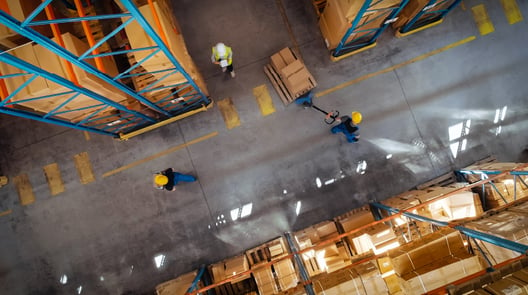In the fast-paced and increasingly complex consumer-packaged goods (CPG) industry, the supply chain acts as the backbone of operations. That is, it dictates the efficiency, responsiveness, and ultimately, the success of enterprises. As the practice of supply chain management and strategy improves over time, transformative advancements occur every now and then to change the game. One of the more recent and most disruptive of these advancements is the integration of digital twin technology into this practice.
A digital twin, in essence, is a virtual replica of a physical system. For supply chain and manufacturing analytics, a digital twin can become a dynamic, digital mirror of the entire supply chain network by continuously collecting real-time data from internet-of-things (IoT) sensors and other sources across the supply chain — from production lines and distribution to storage network. This technology goes beyond mere simulation. It creates a living model of operational systems that managers can interact with, learn from, and optimize via predictive AI.
%20(1)%20(1).jpg?width=346&height=346&name=SocMed%20posts%20for%20Digital%20Twins%20(2.2)%20(1)%20(1).jpg)
Digital twins vastly differ from traditional modeling. While conventional models offer relatively static, often one-off frames, digital twins provide a live, constantly updated representation of an interconnected ecosystem. For supply chains, digital twins provide comprehensive visibility, which fosters cross-functional collaboration and seamless alignment of various supply chain components. Moreover, advanced analytics can be used on digital twins to produce dynamic and predictive insights that enable continuous optimization and real-time, proactive decision-making. This makes digital twins a more integrated and responsive tool in comparison to traditional modeling and simulation methods.
In the CPG industry, where the slightest inefficiencies can escalate costs and diminish customer satisfaction, digital twins offer an unprecedented level of insight and control. For instance, in a past project with a global CPG firm, the implementation of a digital twin in a key supply chain segment led to a 15% reduction in inventory holding costs and a 9% improvement in delivery times. These numbers aren't just metrics — they represent a tangible competitive advantage in a market where agility and efficiency are paramount.
The evolution of digital twins in supply chain management
The evolution of digital twins in supply chain management has been a remarkable transformation, from being a concept to becoming a critical tool for operational excellence. The term “digital twin” was first coined in the early 2000s, but its practical implementation only grew in the last decade, particularly in the CPG industry. Initially, these systems served as basic simulation models, allowing for forecasting and planning. However, as technology advanced, so did the capabilities of digital twins.
A significant turning point was the integration of the IoT and AI. This integration enabled the transition from static models to dynamic learning systems capable of real-time analysis and decision-making. According to a 2023 report by Gartner, the implementation of IoT in digital twins saw a surge, with over 60% of new industrial IoT projects incorporating digital twin technology by the end of 2022.
To demonstrate a practical example, the supply chain analytics (SCA) practice at Lingaro developed a digital twin for a leading CPG company that not only mapped their production line but also integrated real-time data from IoT-enabled devices. This system used AI algorithms to predict equipment failures, optimize maintenance schedules, and even streamline manufacturing bottlenecks when updating production plans based on changing market demands. All of these showcase the advanced capabilities of modern digital twins.
The progression of digital twins can also be benchmarked against the growing complexity and scale of the data they handle. A study by McKinsey in 2023 highlighted that advanced digital twins in the CPG industry are now capable of processing petabytes of data from diverse sources, including supplier networks, logistics, and business insights. This large-scale data integration grants comprehensive supply chain visibility and facilitates strategic decision-making, both of which were impossible to do a year ago.
%20(2)%20(1).jpg?width=346&height=346&name=SocMed%20posts%20for%20Digital%20Twins%20(1.12)%20(2)%20(1).jpg)
Another notable trend in the evolution of digital twins is the shift toward collaborative ecosystems and the collaborative planning, forecasting and replenishment (CPFR) model. Simply put, digital twins are no longer just tools for individual companies because they have also become platforms for collaboration among suppliers, manufacturers, and retailers. According to a 2023 Harvard Business Review article, this ecosystem approach enables a more holistic view of the supply chain, enhancing efficiency and resiliency across the value chain. The direction for developing this capability is very clear. According to an Accenture study, more than 70% of supply chain executives expect their organization’s investment in digital twins to increase in the next three years.
Practical applications of digital twins in the CPG industry
Let’s take a look at some of the real-world applications of digital twins in the CPG sector.
Enhancing production efficiency and product quality
-
Predictive maintenance and downtime reduction: At one Fortune 500 CPG company, we observed the deployment of a digital twin that predicted equipment failures before they occurred. This predictive maintenance led to a 22% reduction in unplanned downtime.
-
Quality control: Using digital twins for real-time monitoring of production processes ensures consistent product quality. For instance, a digital twin can track deviations in product variability specifications and immediately suggest corrections. This reduces waste and helps firms abide by the principles of Six Sigma and lean manufacturing, which ensure product availability and strengthen their supply chain service level.
-
Overall equipment effectiveness (OEE): OEE is a product metric of the availability, quality, and performance of a company’s production assets. Digital twins can influence and uplift all three OEE components by increasing uptime and utilization capacity, reducing defect rates, and enhancing efficiency. For instance, the data collected from a firm’s advanced planning system (APS), enterprise resource planning (ERP), and contextualized IoT data can be used to create a real-time optimization model. This model can identify key root causes of availability or performance inefficiencies and predict the parameters that would alleviate the issues, hence providing a solution.
Optimizing Inventory and supply chain management
-
Demand forecasting: Digital twins enable more accurate and dynamic demand forecasting by analyzing consumer behavior, market trends, historical sales data, and other data from different supply chain pillars such as production and scheduling data. This results in better stock management, reduced overproduction, and lower inventory costs.
-
Proactive contingency planning: In one of our projects, we used a digital twin to model complex supply chain networks. We used the model to identify potential bottlenecks and simulate the impact of external disruptions like weather or geopolitical events. This enabled proactive contingency planning, which enhanced supply chain resilience. We were also able to simulate what would happen if another pandemic hit Europe. We predicted the sales performance of certain SKUs and product families, locations that would become overstocked, and production sites that would run out of capacity.
Improving distribution and logistics
-
Route optimization: Digital twins can simulate various distribution scenarios, including route optimization for delivery trucks. This leads to reduced fuel costs and faster delivery times.
-
Maximized storage layouts: By creating digital replicas of warehouse operations, companies can optimize storage layouts and automate picking processes, increasing efficiency and reducing human error.
The practical applications of digital twins in the CPG industry are vast and varied. They not only enhance operational efficiency but also open new avenues for innovation, sustainability, and customer engagement. Digital twins are a cornerstone for the future of efficient and responsive supply chain management in the CPG sector, and they’re going to be as fundamental as having an ERP system within the next three to five years.







